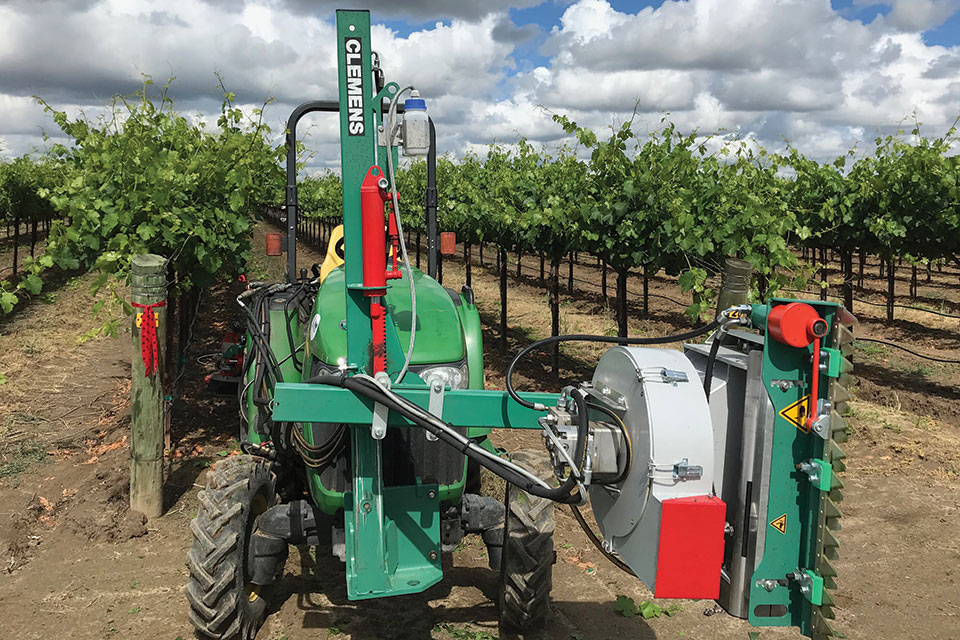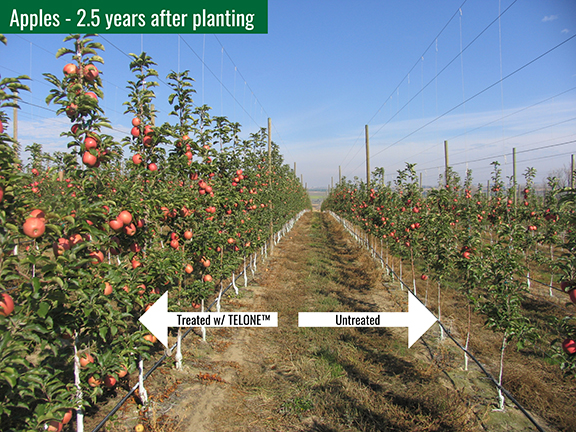Wine Grape Pruning Expenses Slashed with Mechanization

Clemens mechanical leafing equipment is seen in front of a quadrilateral cordons sprawling system of ‘Petite Sirah.’ (Photo: George Zhuang, UCCE)
George Zhuang is so close to his goal, he can almost taste it, and it would be as exquisite as the finest wine.
Zhuang is a University of California Cooperative Extension Viticulture Advisor in Fresno County, where most growers have successfully implemented mechanical harvesting, so Zhuang and colleagues such as Kaan Kurtural, a UCCE Specialist in the UC Davis Department of Viticulture and Enology, are tackling mechanical pruning.
“Here in the (San Joaquin) Valley, the biggest labor cost besides harvest is pruning,” says Zhuang. “If we can do mechanical pruning and mechanical harvest, there’s not much left, it’s called a no-touch vineyard.”
The “no-touch vineyard” would certainly be a lot less expensive to farm. Zhuang estimates mechanical pruning reduces pruning costs by 90%. The actual cost savings depends on many factors, such as variety, etc. In the Fresno area, he says a typical vineyard with 500 vines per acre costs about $500-$700 an acre to prune by hand. But using a machine costs only about 8 cents per vine, dropping the cost down to less than $50 per acre, a huge savings, especially when combined with machine-harvesting.
“Mechanization of your vineyard is probably the most important thing you can do,” he says.
Grower Buy-In
One grower who is in full agreement with Zhuang is Nick Davis of The Wine Group, the second-largest U.S. wine company, which farms 13,000 acre of wine grapes in Central California. Davis is Vineyard Manager, Southern Valley Properties, which includes 3,000 acres of wine grapes, all of which will be completely mechanized if Davis gets his wish.
“It would be a game-changer,” he says. “We feel fortunate to utilize this technology — unlike stone fruit growers, for example.”
Davis says his company has long sought to mechanize operations because of the increasing cost of labor. The state of California raised its minimum wage to $12 an hour this year, part of a plan to eventually raise it to $15 in 2023.
“And we don’t believe it’s going to stop at $15,” he says.
The key to moving to mechanized pruning for Davis, as it is for many growers, is converting their existing California Sprawl growing system, which has a canopy height of 44 to 46 inches, to a single wire cordon at 66 to 68 inches. He thinks they will succeed, thanks in no small part to UCCE advisors like Zhuang.
“We don’t really have an R&D arm, so we really rely on George and Cooperative Extension to provide viticultural knowledge and methods to help us achieve our production goals,” Davis says. “We really enjoy our collaboration with UC Extension — through them we can attain the best quality grapes in our vineyards.”

V-Mech mechanical shoot thinner on single-wire trellis of ‘Petit Verdot.’ (Photo: George Zhuang, UCCE)
Higher Yields Too
Mechanical pruning not only reduced labor costs by 90%, it resulted in increased grape yields and had no impact on the grape berry’s anthocyanin content. That’s welcome news for growers because the cost of re-establishing a vineyard in the region is roughly $15,600 per acre.
The research was conducted on an 8-acre portion of a 53-acre, 20-year-old ‘Merlot’ vineyard in Madera County. After completion of the research project, the grower converted the rest of the 53-acre vineyard to single high-wire sprawling system. Many other wine grape growers have followed suit.
“We found that growers do not have to plant a new vineyard to mechanize their operations,” says Kurtural. “We have proven beyond a doubt that an older vineyard can be converted to mechanization. There is no loss in yield during conversion and post-conversion yield is better and fruit quality is equivalent to or better than hand-managed vines.”
The Madera field study was conducted for three consecutive seasons. In this area, traditional vineyards are head-trained to a 38-inch-tall trunk above the vineyard floor and two eight-node canes are laid on a catch wire in opposite directions and two eight-node canes are attached to a 66-inch high catch wire. Although this traditional training system can work for mechanical harvesting, it doesn’t accommodate mechanical dormant pruning and shoot removal with limited success in other mechanical canopy management operations.
To accommodate mechanical pruning and shoot removal, the vines were converted to a bilateral cordon-trained, spur-pruned California sprawl training system, or to a bilateral cordon-trained, mechanically box-pruned single high-wire sprawling system. The latter option proved to be the most successful system for mechanical pruning in the San Joaquin Valley, where more than half the state’s wine grapes are grown.
“California Sprawl is good for mechanization, but there is a problem: You have cross-arms, and a cross-arm with two catch wires is a big problem for mechanical pruning,” Zhuang says. “A lot of growers in my area getting rid of cross arms; without the cross-arms, you would probably be very close to single-wire.”
Further Research
Interestingly, because the canopy architecture and yield characteristics of mechanically pruned vines are different from vines that are hand-pruned, the water and fertilizer requirements for the mechanically pruned vines can be quite different, says Zhuang.
“So we are studying the yield and fruit quality of grapes produced on different rootstocks in mechanical pruning systems in the San Joaquin Valley,” he says.
Zhuang says they started the mechanical pruning work specifically on wine grapes because the production trellis is easier to work with on wine grapes. Now that they have had some success, they have become researching raisin grapes. While 90% of the wine grapes in the San Joaquin Valley are machine-harvested, more than half the raisins — many of them the old ‘Thompson’ variety — are still harvested by hand.
“Table grapes will be last because the production system would have to change,” he says. “Fresh fruit needs cosmetic beauty, and the canopies are much bigger because its all about getting more tons per acre.”
As for wine grapes, Zhuang says more developments are on the horizon.
“Precision viticulture is just starting right now. Here in the valley, where the average vineyard is 500 acres, growers are thinking ‘How can we produce crops uniformly across large acreages?’ Kaan Kurtural is working intensely on satellite mapping to allow for differential management to increase uniformity,” he says. “We’re now employing precision ag to boost production even higher — now that we’ve got rid of the labor.”









